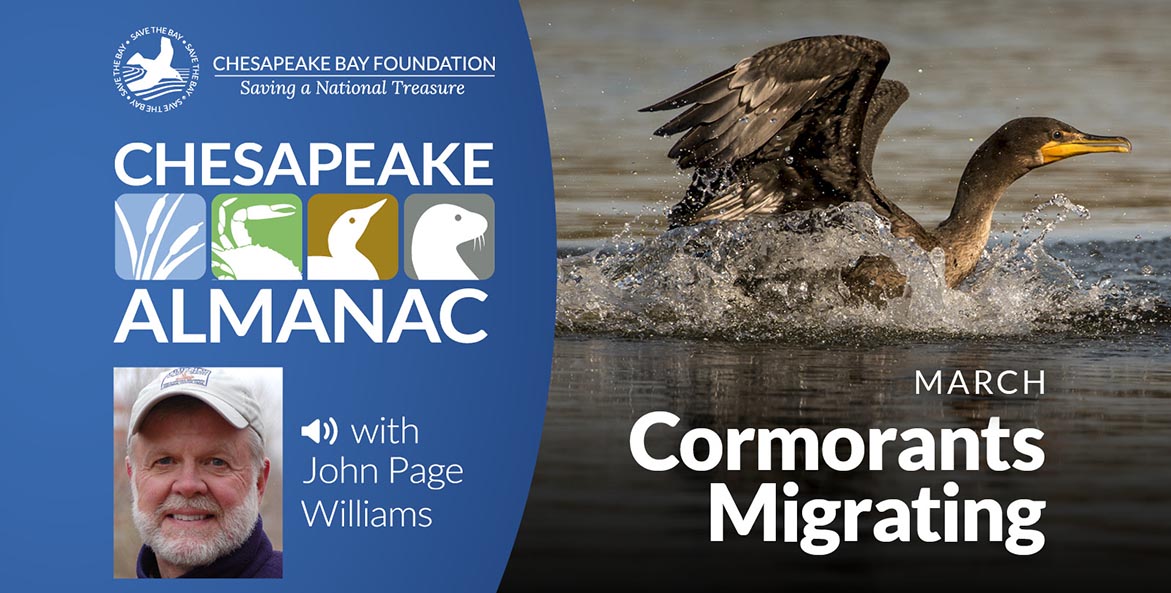
Chesapeake Almanac
Episode 1: March: Cormorants Migrating
Copyright © John Page Williams Jr. All rights reserved.
This is John Page Williams with another reading from my Chesapeake Almanac. This entry is from March and it's entitled, "Cormorants Migrating." It was Cape May Point in Delaware Bay, not the Chesapeake, and it was early October, not March. So the birds were headed south. Up high and out in the distance, a long V of large, dark birds appeared, flapping their wings steadily.
They were the right size, the wing beat had the right cadence, and the time was right. Except that these birds were entirely dark, with long square tails, and necks that were crooked in the middle and a little too short. Besides, they weren't honking; they were silent. When they came directly overhead, it was easy to get a good look at them. They were actually double-crested cormorants. Most of us, if we think of cormorants at all, think of pictures we've seen of oriental watermen of a century ago, using birds with rings around their necks to catch fish. Maybe so, but for most of the year, double-crested cormorants are very much a part of our world here on the Chesapeake.
This bird is the only cormorant species that appears commonly on the Bay, (there are several others around the world, including the one used in the Orient). The double-crested cormorant comes in large numbers as a transient in both spring and fall. The birds flying over Cape May Point could easily have been headed for a stopover stopover of several weeks on the way to wintering grounds farther south.
Now in the early spring, the same birds will be working their way back north, and flocks of them will pause here to fish. They will be largely unnoticed by humans, though, mostly because there are relatively few people out on the water to see them.
All semblance to geese ends quickly on close examination. The basic [00:02:00] design of cormorants has not changed much in millions of years, primarily because it is an effective one for a fish-eating migratory bird that dives and swims underwater to catch its prey. The cormorants are related to two other successful fishing designs, pelicans, and gannets. They are, however, the only ones in the group that swim extensively underwater, so they do not use the dive-bombing tactics of their more spectacular kin.
The Virginia Society of Ornithology lists the double-crested cormorant as an abundant transient from March 5th to May 30th and from August 10th to May 20th. It is an "irregular and locally common winter resident and summer visitor," with one breeding record from the south bank of the James.
More generally, the birds winter in a long band along the southern coast of the United States and breed in the summer along the rocky coast of New England, the Canadian Maritime Provinces, and Newfoundland. With the Chesapeake a good source of fish squarely on the route between wintering and breeding areas, it's no wonder that large numbers of them stop off here in migration.
The birds do not all breed at same time, but stagger the nesting over a couple of months in the summer. Thus the young of a breeding colony will be at various stages of development at any given time, and the families will not migrate all together. Hence the protracted migration periods in both fall and spring.
March is an especially good time for early migrants. The Bay's resident fish populations are beginning to stir, and a few fish are coming in from the Atlantic. In the past, state gill nets and pound nets set for the first herring runs acted as cormorant magnets. A line of 40 stakes would have 40 big black birds perched and resting, drying their wings. But herring runs have fallen off in recent years, fewer watermen set pound nets, and stake nets are heavily regulated. Even so, there will be plenty of cormorants around, resting on channel markers and feeding on anchovies and silversides, as well as whatever herring they can find.
On the water, cormorants have a distinctive profile. They float very low, with their backs nearly awash, necks erect, and long, hooked bills pointing skyward. Their feet and short legs, set far back on the body, are awkward on land but provide powerful propulsion on dives. The bird use their wings underwater as well, and the long beaks become efficient fish catchers. Underwater feeding is always a tricky balance between energy expended in diving and energy acquired from food eaten.
Cormorants' feathers are dense, and they have no oil glands for preening their feathers for buoyancy, which would hinder diving. In exchange for underwater efficiency, they have to put up with the inconvenience of drying their feathers before they can fly. On a line of net stakes, cormorants are almost comical, standing nearly erect on the tops of the stakes with their wings spread in the breeze.
Comical maybe, but the cormorant design is a good one, and it continues to stand the test of time. For anyone who watches the Bay closely, they are a most interesting group of birds, adding yet another dimension to the Chesapeake's year.
For more happenings around the Bay in March see our other Chesapeake Almanac podcasts and read our blog posts "Tiny, Timid, Timberdoodle Dancers," March's Lion Has Lost His Teeth," and "Watching Northern Water Snakes in March."
Subscribe to this podcast at https://chesapeake-almanac.captivate.fm/listen


